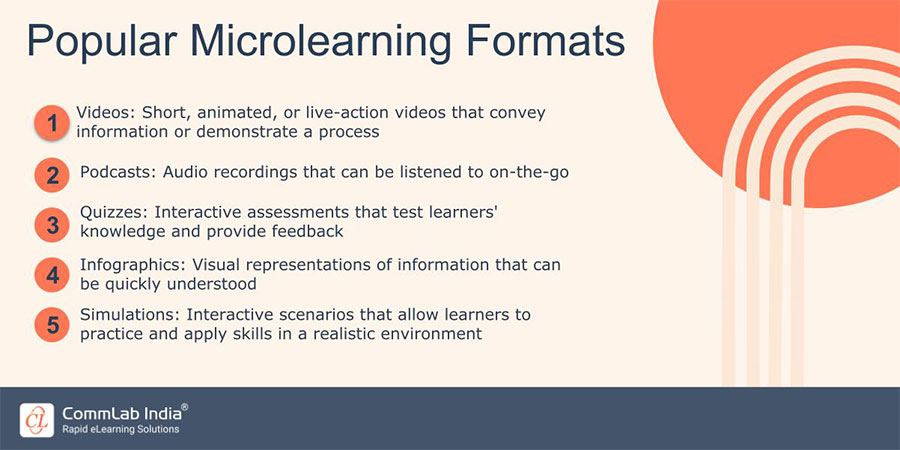7 Questions to Ask Before Implementing Microlearning
Unlock the power of microlearning with our comprehensive guide. Explore key questions for seamless implementation and foster a culture of continuous learning.

A bite-sized approach to learning offers numerous benefits, but its successful implementation requires careful consideration. Before diving into the world of microlearning, it's crucial to ask the right questions to ensure a seamless and effective integration. In this article, we will explore seven key questions that organizations should ponder before embarking on their microlearning journey.
Are Various Questions Bothering You While Implementing Microlearning?
7 such questions are answered below -
- What are your learning objectives
- What is the content format
- What is the frequency of microlearning modules
- How will you foster a learning culture
7 Questions to Ask Before Implementing Microlearning
1. What are Your Learning Objectives?
To effectively leverage microlearning, start by establishing clear and measurable learning objectives. Consider the specific skills, knowledge, or behaviors you aim to impart to your employees. For example, if your goal is to enhance customer service skills, break it down into smaller objectives such as effective communication, problem-solving, and empathy.
Once you've identified your learning objectives, prioritize them based on their importance and relevance to your organization's overall goals. This prioritization will guide the development and sequencing of microlearning modules. Remember that microlearning is most impactful when it addresses specific learning outcomes, making it crucial to align your objectives with organizational priorities. Here’s a short video to help you understand the importance of learning analytics.
2. Who is Your Target Audience?
Understanding your target audience is crucial for tailoring microlearning content to their needs and preferences. Start by analyzing the demographics of your employees, including age, experience level, and job roles. This information will influence the complexity and format of microlearning content.
Consider the learning styles and preferences of your audience. Are they more receptive to visual content, interactive simulations, or textual information? For example, younger employees might prefer video-based microlearning, while more seasoned professionals may appreciate in-depth written content or interactive scenarios.
→ Sign Up for Webinar Now: Microlearning Training Challenges
3. What is the Content Format?
Microlearning content comes in various formats, such as videos, infographics, and interactive simulations. Deciding on the right format depends on your learning objectives and your audience's preferences. For instance, complex procedures may be better conveyed through interactive simulations, while quick tips and tricks might be more effectively communicated through short videos. By determining the optimal content format, you can maximize the impact of your microlearning initiatives.

Additionally, consider the duration of the microlearning modules. While the term "micro" suggests brevity, the optimal length may vary based on the complexity of the content. Strive to strike a balance between providing enough information to meet the learning objective and maintaining the attention of the learner.
4. How Will You Measure Success?
Defining key performance indicators (KPIs) is essential for evaluating the success of your microlearning program. Consider both quantitative and qualitative measures to gain a comprehensive understanding of its impact. Quantitative measures could include completion rates, assessment scores, and the application of knowledge in real-world scenarios. Tracking these metrics provides insight into the effectiveness of the microlearning modules and the engagement levels of your employees.
Qualitative measures involve gathering feedback from learners through surveys, focus groups, or interviews. Understand how employees perceive the value of microlearning, identify areas for improvement, and gather suggestions for future topics. Additionally, correlate microlearning outcomes with broader organizational goals, such as improved employee performance, increased productivity, or a reduction in training costs. A well-defined measurement strategy enables data-driven decision-making with the help of advanced learning analytics, allowing you to refine and enhance your microlearning program over time.
5. What is the Frequency of Microlearning Modules?
Determining the frequency of microlearning modules requires finding the right balance between providing consistent learning opportunities and avoiding information overload. Consider the nature of your content and the pace at which your employees can realistically absorb new information. If your microlearning content focuses on quick tips or updates, a higher frequency, such as daily or bi-weekly, might be suitable. However, for more in-depth or complex topics, a weekly or monthly schedule could be more appropriate.
Take into account the time constraints of your employees' daily responsibilities. Microlearning is designed to be concise and time-efficient, so align the frequency with the available time employees can dedicate to learning without compromising their regular tasks. Furthermore, consider creating a varied schedule to keep the content fresh and engaging. For example, alternate between different formats or themes to maintain interest and cater to diverse learning preferences.
6. How Will You Support Continuous Learning?
Integrating microlearning into a broader strategy for continuous learning involves considering how it complements other training initiatives and resources. Determine how microlearning modules fit into the overall learning ecosystem of your organization. Explore opportunities to link microlearning with traditional training sessions or workshops, creating a seamless transition between different learning modalities. For example, use microlearning as pre-training or post-training reinforcement to enhance retention and application of knowledge.
Regularly assess the effectiveness of your continuous learning strategy by soliciting feedback from participants and monitoring key performance indicators. Adjust the approach based on evolving organizational needs and learner preferences to ensure a dynamic and responsive continuous learning environment.

7. How Will You Foster a Learning Culture?
You can start by establishing leadership support for learning initiatives. When leaders actively promote and participate in a strong and continuous learning culture, it sets a positive example for the rest of the organization. Encourage leaders to share their learning experiences and emphasize the importance of ongoing development. Implement recognition programs to celebrate achievements and milestones in learning.
Acknowledge employees who actively engage with microlearning, apply their knowledge, and contribute to a culture of shared learning. Recognition can be formal, such as awards or certificates, or informal through shout-outs in team meetings. Promote a collaborative and knowledge-sharing environment by creating platforms for employees to share insights, tips, and best practices. This could include online forums, discussion groups, or collaborative projects that encourage the exchange of knowledge and skills.
Wrapping Up!
In conclusion, the implementation of microlearning requires thoughtful consideration and strategic planning. By addressing these questions, organizations can create a tailored and effective microlearning program that aligns with their goals, engages their employees, and fosters a culture of continuous learning. Embracing microlearning as a dynamic and adaptable training solution can undoubtedly lead to enhanced employee performance and organizational success. We have a webinar coming up on microlearning, and that will definitely sort out your remaining doubts, so make sure you sign up for it.





